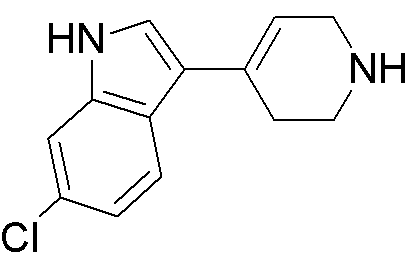6-Chloro-3-(1,2,3,6-tetrahydropyridin-4-yl)-1H-indole is widely utilized in research focused on:
- Pharmaceutical Development: This compound serves as a key intermediate in the synthesis of novel pharmaceuticals, particularly in the development of drugs targeting neurological disorders.
- Neuroscience Research: It is used in studies investigating the mechanisms of action of neurotransmitters, aiding in the understanding of brain function and potential treatments for mental health conditions.
- Medicinal Chemistry: Researchers leverage its unique structure to design and optimize new compounds with improved efficacy and reduced side effects compared to existing medications.
- Biological Assays: The compound is employed in various biological assays to evaluate its effects on cellular processes, providing insights into its therapeutic potential.
- Drug Discovery Platforms: It is integrated into high-throughput screening processes to identify promising drug candidates, streamlining the path from discovery to clinical application.
General Information
Properties
Safety and Regulations
Applications
6-Chloro-3-(1,2,3,6-tetrahydropyridin-4-yl)-1H-indole is widely utilized in research focused on:
- Pharmaceutical Development: This compound serves as a key intermediate in the synthesis of novel pharmaceuticals, particularly in the development of drugs targeting neurological disorders.
- Neuroscience Research: It is used in studies investigating the mechanisms of action of neurotransmitters, aiding in the understanding of brain function and potential treatments for mental health conditions.
- Medicinal Chemistry: Researchers leverage its unique structure to design and optimize new compounds with improved efficacy and reduced side effects compared to existing medications.
- Biological Assays: The compound is employed in various biological assays to evaluate its effects on cellular processes, providing insights into its therapeutic potential.
- Drug Discovery Platforms: It is integrated into high-throughput screening processes to identify promising drug candidates, streamlining the path from discovery to clinical application.
Documents
Safety Data Sheets (SDS)
The SDS provides comprehensive safety information on handling, storage, and disposal of the product.
Product Specification (PS)
The PS provides a comprehensive breakdown of the product’s properties, including chemical composition, physical state, purity, and storage requirements. It also details acceptable quality ranges and the product's intended applications.
Certificates of Analysis (COA)
Search for Certificates of Analysis (COA) by entering the products Lot Number. Lot and Batch Numbers can be found on a product’s label following the words ‘Lot’ or ‘Batch’.
*Catalog Number
*Lot Number
Certificates Of Origin (COO)
This COO confirms the country where the product was manufactured, and also details the materials and components used in it and whether it is derived from natural, synthetic, or other specific sources. This certificate may be required for customs, trade, and regulatory compliance.
*Catalog Number
*Lot Number
Safety Data Sheets (SDS)
The SDS provides comprehensive safety information on handling, storage, and disposal of the product.
DownloadProduct Specification (PS)
The PS provides a comprehensive breakdown of the product’s properties, including chemical composition, physical state, purity, and storage requirements. It also details acceptable quality ranges and the product's intended applications.
DownloadCertificates of Analysis (COA)
Search for Certificates of Analysis (COA) by entering the products Lot Number. Lot and Batch Numbers can be found on a product’s label following the words ‘Lot’ or ‘Batch’.
*Catalog Number
*Lot Number
Certificates Of Origin (COO)
This COO confirms the country where the product was manufactured, and also details the materials and components used in it and whether it is derived from natural, synthetic, or other specific sources. This certificate may be required for customs, trade, and regulatory compliance.


